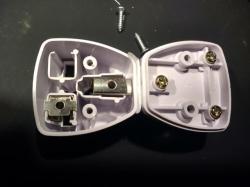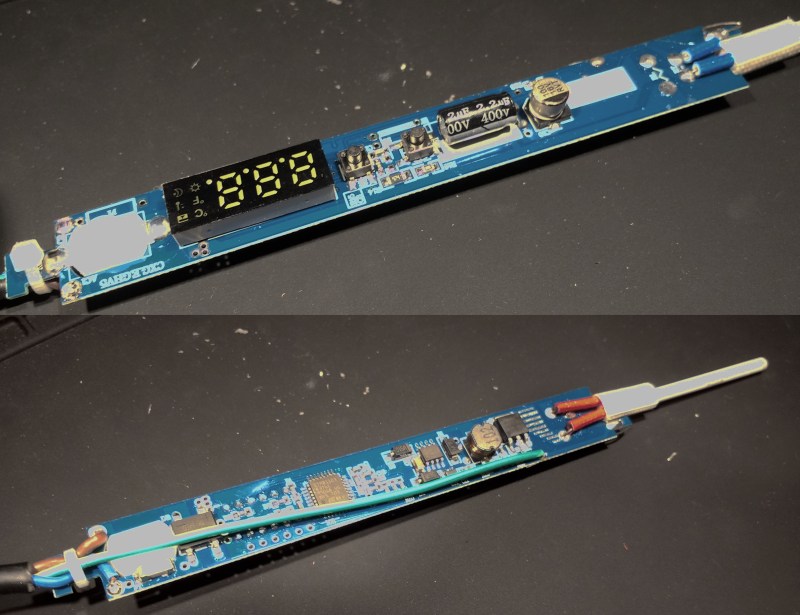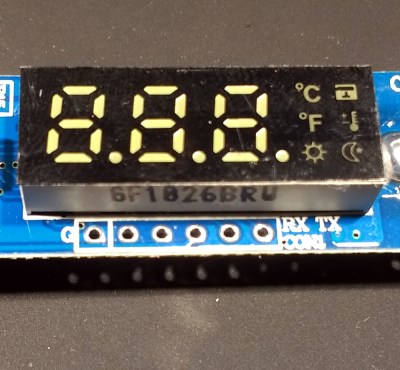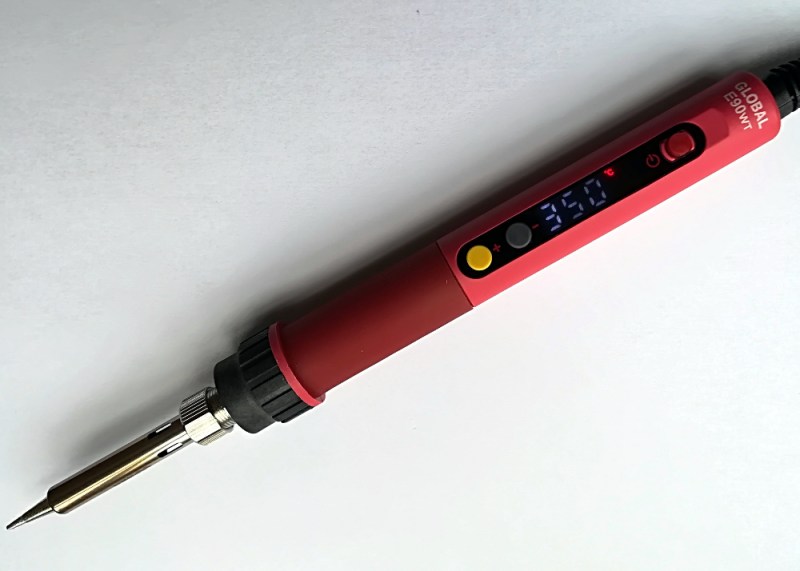It’s an entertaining pastime when browsing the array of wonders available from the other side of the world at the click of the mouse, to scour the listings of the unusual, the interesting, or the inexpensive. Sometimes when you find something unexpected you are rewarded with a diamond in the rough, while at other moments your bargain basement purchase is revealed as a hilariously useless paperweight. This is a game in which the stake is relatively low and the reward can be significant, so rarely does an order for some parts or sundries go by without a speculative purchase.
The latest to arrive is a soldering iron. The CXG E90W is a 90W mains-powered temperature controlled iron with its control electronics built into its handle. Such irons are by no means unusual, what makes this one different is that it has a low price tag.
The Miniware TS100, an iron I quite like and the current darling of the pack, is priced at nearly £50 ($71). Just how can this iron priced at just under £15 ($21) be any good? I placed one on the order, and waited for delivery.
Unpacking the box we have the iron itself, an instruction sheet in Chinese and English, and one of those little folded metal rests. Your tastes may vary, but I ignored the final item as I have always preferred a full-size soldering iron stand.
How It Measures Up
The iron itself is about 220mm (8.75″) long, of which about 70mm (2.75″) is the element shroud and tip, the rest being a plastic handle about 20mm (0.9″) in diameter. It weighs about 68g (2.4oz). On the side of the handle is a black panel with an LED display, two buttons to control the iron, and a mains on/off switch with a pleasing click action. The mains cable is fairly standard stuff rather than the extra-flexible silicone you’ll find on more expensive irons, it’s about 1.5m (5′) long, and my European variant had a Schuko-style Continental European plug for which the supplier had given me one of those downright lethal adapters to a British BS1363A plug. The same iron can also be had with an NEMA-style plug for those parts of the world who take their electricity at 120-ish volts.
 Amusingly for once the BS1363A adapter was perfectly safe if completely useless. Its manufacturer hadn’t fitted any of the metalwork on the live side. Consider just fitting a safe plug if you have one of these adapters.
Amusingly for once the BS1363A adapter was perfectly safe if completely useless. Its manufacturer hadn’t fitted any of the metalwork on the live side. Consider just fitting a safe plug if you have one of these adapters.
The iron is supplied with a general purpose tip, ideal for all through-hole and larger SMD work, but probably a bit large for more fine-scale work. Fortunately the tips are the familiar Hakko 900M series, so there should be no difficulty in finding suitable upgrades. Powering it on you see the 7-segment display cycle through the temperature readings as it reaches its 350 degree Celcius default setting. It’s no slouch in the speed stakes, heating up in a similar time to my TS100 and more quickly than my trusty Antex. Setting the temperature anywhere between the limits of 80 degrees to 500 degrees is simply a matter of a long press on the yellow button before using the two buttons to move the figure up or down.
Test Run
Description behind us, what’s the iron like to use? To test it I pulled out the other item I’d put on my order, a little through-hole soldering kit for a low frequency function generator that had cost me the princely sum of £4.50 as a test item for the iron. It is hardly a challenging piece of construction, but it has a good mix of 0.1″ spaced components with larger metal-bodied potentiometers and connectors. It should give any soldering iron with a general-purpose bit an easy work-out.
When soldering, the iron’s size was not the issue users of more svelte irons such as the TS100 might expect it to be. It has a slim girth and light weight, so despite its length is was not cumbersome in any way. There was plenty of heat when it was needed as you might expect from a temperature-controlled iron, and never any of those awkward will-it-melt moments. Given an appropriate tip this would not be the wrong tool for either bigger or smaller work.
A Look Under The Hood

When you buy a cheap mains-powered item from the other side of the world, it’s always a good idea to take a look at its mains safety — especially when you’ll be holding onto it during operation. Dismantling the E90W is a straightforward enough process, simply unscrew the shroud and remove the tip, then unscrew the collar at the base of the element. The PCB will then slide out as you feed the mains cable through its strain relief grommet.
The board runs the full length of the handle and has display and switches on one side, and much of the electronics on the other. The main semiconductor components from one side to the other are a bridge rectifier fed by the mains input, an ST Microelectronics STM8S103K3 microcontroller, an SSMC SM7015 low voltage power supply chip for which I can only find a Chinese datasheet, and a Haolin HD840L high voltage power MOSFET. The display is a seven-segment unit rather than the expected OLED.

Starting at the mains input, cable strain relief is provided by the usual flexible grommet and a cable tie securing it to the board. I would have preferred to see the cable tie gripping the outer insulation rather than the wires themselves, but I have seen far worse. The two live and neutral wires join the board immediately and are fed into the click-action mains switch, while the earth wire is much longer and goes almost the full length of the board before joining a short track to a spring contact designed to touch the element shroud and earth the tip. At the element end there is a reasonable distance between the high-voltage track and the earth track, certainly much more than you will find as the isolation barrier between tracks in many phone chargers.

Interestingly there is an unpopulated header for a serial port, giving us the possibility that the little 8-bit microcontroller could be hackable. It won’t give you the versatility of the TS100’s ARM Cortex and OLED display, but there must be software tweaks that could be made to the iron. If you are the type of person who routinely hooks up serial ports to embedded microcontrollers you will probably know this already but it has to be said anyway: this serial port is on a live board that is not isolated from the mains in any way. To use it you will need to unplug the iron from the mains, and connect your own low voltage supply to the iron’s processor. Not taking this advice will damage your computer and probably expose you to a dangerous electric shock risk. We like our readers to remain alive.
The element is a ceramic unit, which according to the instruction sheet is removable and replaceable. One thing to watch out for when disassembling the iron, on mine the red silicone rubber power button came out as I removed the PCB. If this happens to you, don’t try to refit it down the length of the handle with a pair of tweezers, instead it just pushes in from the outside with the aid of a small screwdriver to ease its lip past the bezel.
Our Verdict: Consider This Iron

The CXG E90W is a temperature controlled soldering iron with plenty of power that seems to be a perfectly reasonable performer and takes standard tips, for an extremely low price. Having taken it apart I’m satisfied with its level of insulation and mains safety though a little more strain relief wouldn’t be a bad thing. I really like it for its on-off switch, something I wish more irons would incorporate. That it has a possibility of being hackable is a bonus, though most users will just need a stock soldering iron. It’s not going to trouble the Wellers of this world and it’s not as light as some of its competition, but it’s a perfectly usable size and weight, has decent build quality, and of course that price is very low. It’s not going to displace my TS100, but I can see that it might tempt quite a few buyers who were considering spending three times as much on the Miniware iron. If it were my only iron, I’d be happy with it.
Postscript: My £4.50 function generator kit was a well-designed little board with a really nice laser-cut Perspex case, that was a joy to build while testing the E90W. Unfortunately though the function generator kit shown here is let down by atrocious quality potentiometers, and is one of those items where you need to waggle the controls a little to get it to work. It’s not worthy of a review of its own, suffice to say that if you pay £4.50 for a kit you can expect the quality to be variable. I’m still on the hunt for a better function generator.















How’s the temperature accuracy and recovery time?
Okay, now I have to get one and do my own test…
This iron is actually looking pretty appealing. Killed the heating element on my Aoyue 936 a couple weeks ago and have been without an iron. Picked up a cheap Harbor Freight iron that was intent to be temporary but it’s so horrific that I’m afraid to even use it to solder a new element down, the thing is just two lines coming from the wall into the heating element with absolutely nothing to limit the power it recieves. As a result it melted it’s cheap copper tip within 5 minutes of use and the barrel felt like it was going to burn my hand through the plastic shroud. I had been considering just ordering a knockoff 936 wand for my Aoyue even though I know they have shoddy elements in them to serve as a temporary and to repair my good wand with but this iron featured cost the same and would also make for a good iron to carry with me since it doesn’t require a base station.
Harbor Freight Rule #3: Don’t plug in anything from Harbor Freight
Horror Fraught
$21? On Amazon right now, $82. Yikes.
Look on Banggood, GearBest, AliExpress etc.
>Just how can this iron priced at just under £15 ($21)
$20 is $5-7 more than the price of DIY Hakko T12 kits on ebay, miles better than ancient shitty 900M tips.
Oh really? STM8S microcontroller with exposed serial pins, did you say?
I have no idea _why_ one would ever want an interactive programming language and shell on a soldering iron, but I absolutely know _how_: https://hackaday.io/project/16097-eforth-for-cheap-stm8s-gadgets
Excellent, 230 volts and Forth, does it get any better!
Must…. not…. click…. buy….
A Forth controlled soldering iron will be a reality in the near future ;-)
I had a closer look at the one I received:
* temperature is measured with a PTC (R-25 is about 47Ohm) in a voltage divider 1k.
* the PCB is a different variant (serial interface not broken out)
It doesn’t appear to be difficult to hack, and I’m looking at different options for interfacing it safely (e.g. using a SI24R1).
Just a heads-up, I’ve had 2 of these irons and they both stopped working very quickly, most likely because the heating element fried when I set it above the default temperature for a very short time (380C). In both instances, the iron worked fine but when I started it up the next day, it failed to get up to temperature.
The heating element is technically replaceable, but the iron is not really designed for frequent disassembly and the heating elements are not that cheap compared to the iron’s price.
Got a 900-series clone station instead and it’s been working fine for months, even at higher temps, and a replacement handle would be cheaper than getting a heating element for the E90W (and a lot easier to replace).
Would be interesting to hear if anyone else had the same experience, as most reviews seem to be based on short-term experiences and not longevity.
It’s a shame because the iron, when it works, is just as good as my current station, but takes up much, much less space.
I also bought a similar 85w iron some years ago. it had a grey translucent handle and a similar pcb, but no on switch iirc. i remember the rubber temp buttons. it burned out after 2 months of infrequent use for odd repairs. I was using it one day when there was a pop and flash, and the handle filled with black soot. I found the pcb so here’s a pic, maybe someone can figure out what failed.
https://i.imgur.com/zXZd2fW.jpg
OK, interesting. I took mine up to 500 degrees and it works still. But I will keep an eye on it, and if necessary follow it up. For the price though I guess it’s something to watch out for.
I thought the whole point of a pot was to be variable. ;-)
:)
My current solder station is somewhat flaky not sure why. So having a cheap backup would be great. Ordered one on aliexpress with shipping it was $23. So see how it goes, worth the try.
Thank you Jenny, I enjoyed your review.
Any time!
I got what appears to be a clone of that with a medium gray body and branded as a PX-988 from Banggood (https://www.banggood.com/PX-988-90W-Backlight-LCD-Digital-Thermostat-Adjustable-Lead-free-Electric-Soldering-Iron-p-1159783.html?cur_warehouse=USA). It came bare — no stand, and one GP tip. From their China warehouse it’s $18.99. I got one a few weeks back and it’s performed way better than my 75W Bakon 950D, which doesn’t seem to have any punch, especially when soldering poorly designed ground plane thru holes with no relief or parts with large shields (e.g. USB). Its strain relief looks wimpy too, but I didn’t bother to tear mine down. I’ve used it on a couple of small kits and a handful or repair work and I was able to breeze through them unlike those I did with the 950D. Now I don’t mind doing 0.1″ long headers which were too painful on the 950D. I hope this thing lasts, since it’s better than any soldering pencil I’ve used since my old 60W Weller pencil croaked 15 or so years ago (and that may be more nostalgia than reality).
No LCD on this one, so it won’t be a direct clone. But probably pretty similar.
It is far more expensive than the £4.50 kit but beware of the FeelTech FY6600 signal generators. The specs are pretty good for what you pay but there are major unresolved issues with it. It doesn’t have an earth connection, the output floats at a high voltage and there are significant firmware issues which cause the units to corrupt its program flash. FeelTech will ignore you if you complain.
very good and nice looking for using it i would like to get one piece
Were those pictures taken with a potato? Welcome to 2018 :)
My bench lighting is quite harsh.
On the Chinese sites it also comes in 110W and 60W versions I see.
After showing that there were serial pins, I would have expected you to hook up to them and at least do a cursory examination of what (if anything) is exposed by them. This is hackaday after all…
Also, agree with the other comment about the pictures. At some point, you might as well just not include the pictures if they are going to be upside-down and overexposed to the point of being comical. They certainly don’t add anything to the review.
Oh, for crying out loud!
While such pictures would probably be unacceptable to Time magazine or Playboy, they are good enough to see what she is getting across.
“We like our readers to remain alive.”
Thank you!
Just ordered the E90WT from Banggood. Normal E90W is marked as production stopped on CXG website. No idea what differs though.
I assumed, since it’s temperature controlled, that 90W was better than 60W (it was also cheaper surprisingly enough). Could someone enlighten me if I made a mistake?
I don’t see any WT on banggood, only W, odd.
If you click product details there’s a small snippet that reads: “Note: The product has been upgraded. We will send the E90WT to you instead of E90W.”
Ah OK, interesting.
Only diff I see is that the W mentions it has an ‘A1326’ heating element whereas the WT has an ‘A139’ heating element their site says.
The tips are the same though.
High price on Amazon, low price on other sites, out of stock on banggood, manufacturer says they’ve stopped making them. Conclusion: those other sites are close-outs of something that will soon disappear. Given CXG’s product line, perhaps they will replace it with something better, but then it won’t be near the close-out price.
Banggood lists E90W as in stock.
You should say it’s the WT that they have in stock right? Which is the newer version.
Banggood has a tendency to have the same listing for items for a while after they updated an item or changed suppliers with a slightly different version, sometimes leading to complaints from customers I noticed.
You’re right. They have E90WT in stock listed as E90W.
All their soldering irons are about 20ish. Look at the usual places, ali, bangood etc…
Where is the “best-effort” reverse engineered SCHEMATIC DIAGRAM? Send this thing to Big Clive for a second bite at the review – especially when it comes to the WILL IT KILL YOU conclusion.
Big Clive isn’t perfect either you know, I’ve noticed he has an obsession with some details while ignoring others. Including stuff that can be tricky.
That’s a general trend with all reviewers though, including the well known ones.
>”Not taking this advice will damage your computer and probably expose you to a dangerous electric shock risk. ”
You have now ruined their anti-hack ploy. Must make you proud to offend our honorable suppliers of cheap commodities by scuttling their simple attempt to keep the product proprietary. ;>)
And the pics weren’t so bad. But the Playboys could be run beside them, just to help us be sure.
These are essentially junk! I had 3 of them in which the element broke within the first 10 minutes of use. It would be a great iron if the elements would survive. I loved it , hence why i kept getting a replacement, but after the third failure its hard to give it another chance.
There is a russian video showing the device pulling 66 watts maximum from wall outlet. I can carelessly assume its 60 watt in real :) And 23 second ish to reach to 400 C. Also pretty impressive for the price. Longevity always the question. And there is a 110 watt version which i couldnt find any info. I would prefer you to give more realistic information to readers here.
How about the idea of buying the 110W Heater from CXG and modify a $3 936 Handle and with a STM32 kit for >2$ and few components to make the best el cheapo diy soldering iron
Just received mine and first impression is decent. But while the decrement button clicks, it requires quite some force to register. Ocular inspection didn’t reveal much but I’m thinking cold joints. Or should I suspect the actual switch?
Notify for how long it works, cuz ppl r commenting their heating element got destroyed multiple times so not sure if i should buy or not
Mine’s just died after using it for 1/2 an hour.Is that a record? Being a cheapskate does anyone have a circuit diagram for it?.Mine is not so fancy. It is a 905C 220v 60 watt model with 2 pots to set it for 200_450 C with a Hitachi HA17358 dual amp to control it.Worked a treat when it did.
I got mine several weeks ago and got it because of these discussions. Used many times already and like it a lot. It heats quickly has a preset at 350c very portable and easy to use. Not bad for $23, lets see if it lasts the year.
There are tons of those irons by CXG. I may be wrong but it seems to me that the CXG irons are among the better China irons. If you check their website, the Exxx series and the Cxxx series are called “economical class”, but they also have a DSxxx series, like the DS90S and DS90T, these are called “industrial grade”. ((Whatever that means). The “xxxxS” models have a backlight, the xxxxT are those without backlight. ALL of them you can find on ali/bangg. etc for +/-$20. Personally I find the DS90T/S most appealing. Of course I don’t *know*, but I assume that all of these are actually temperature controlled soldering irons.